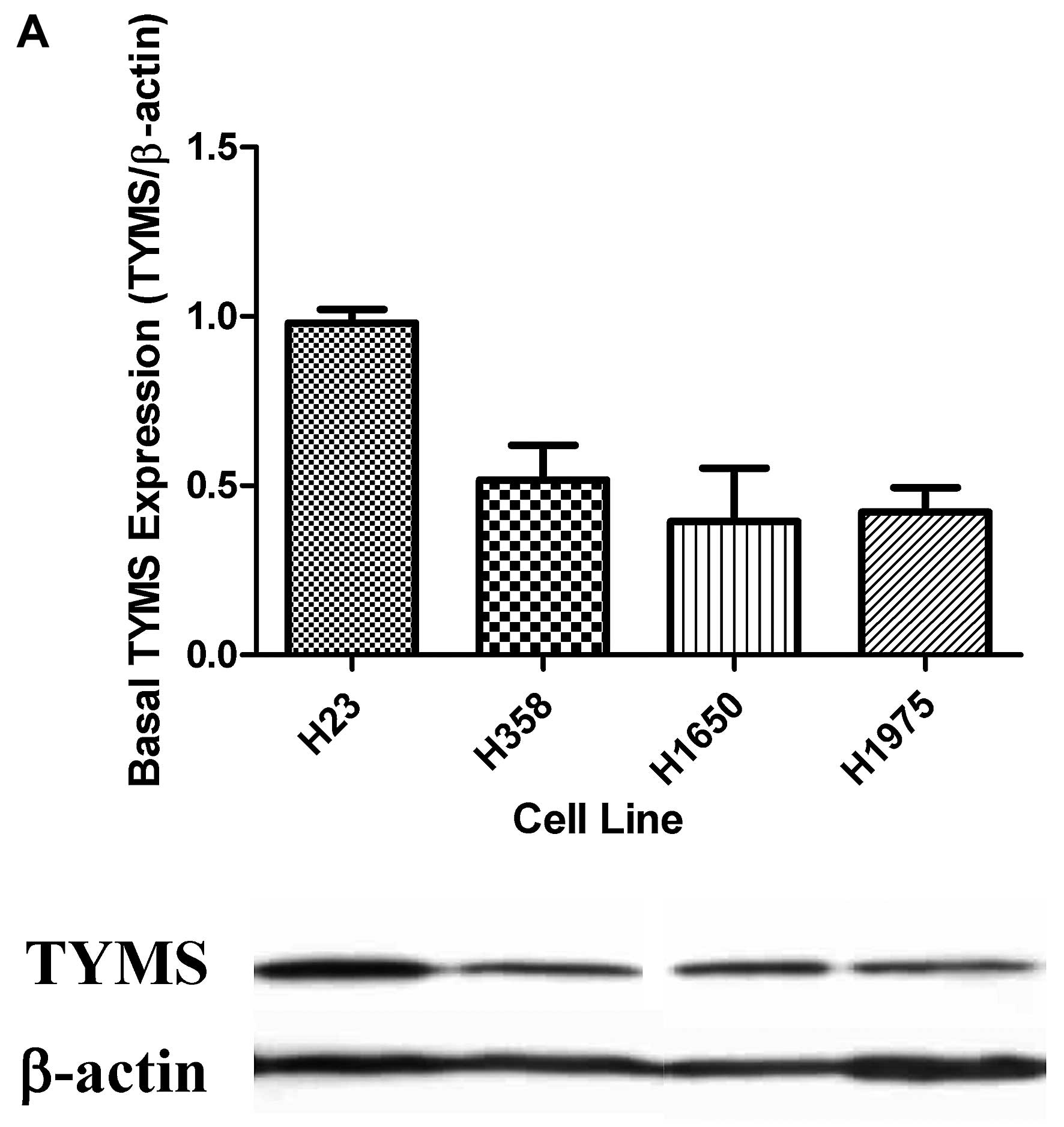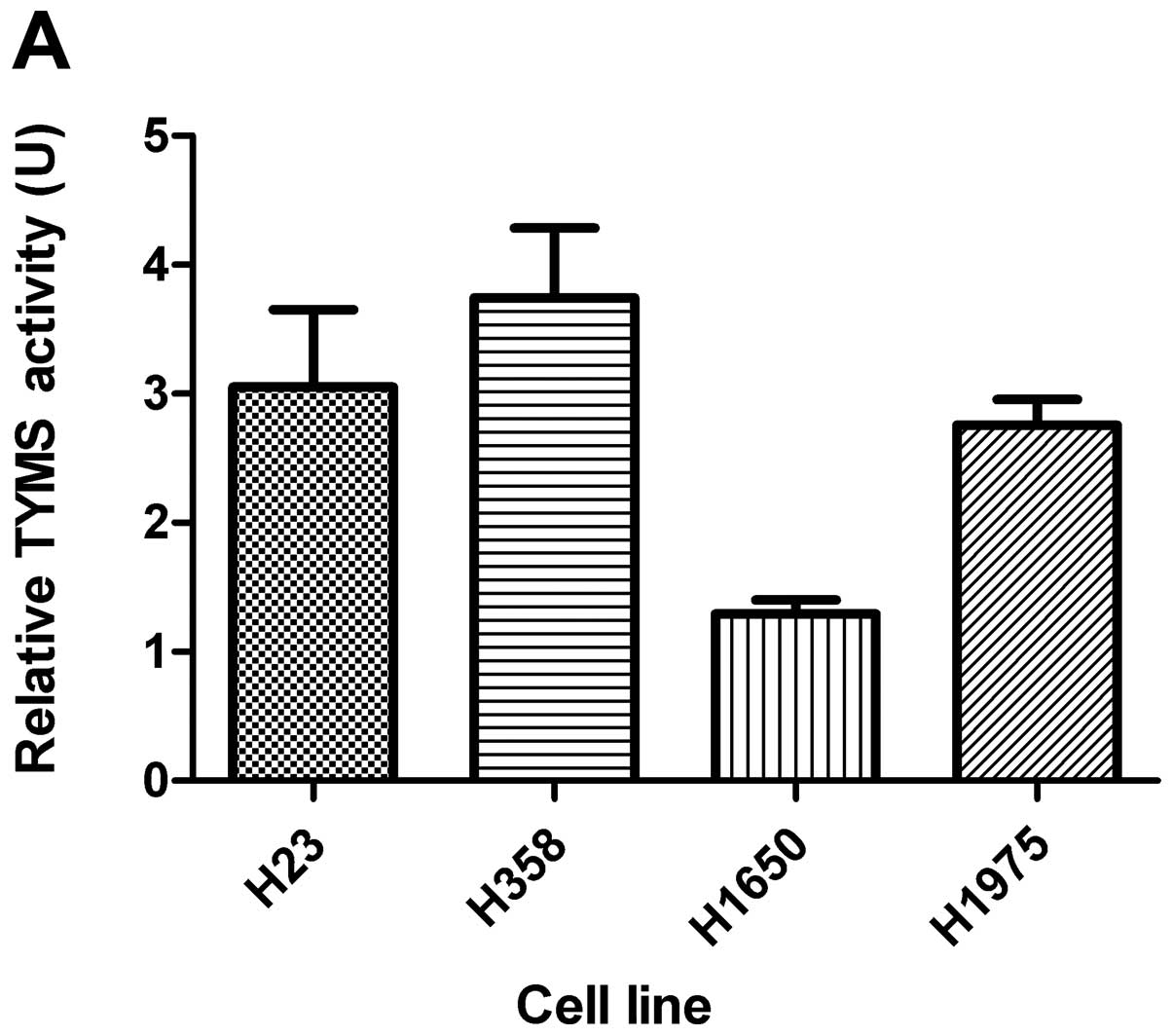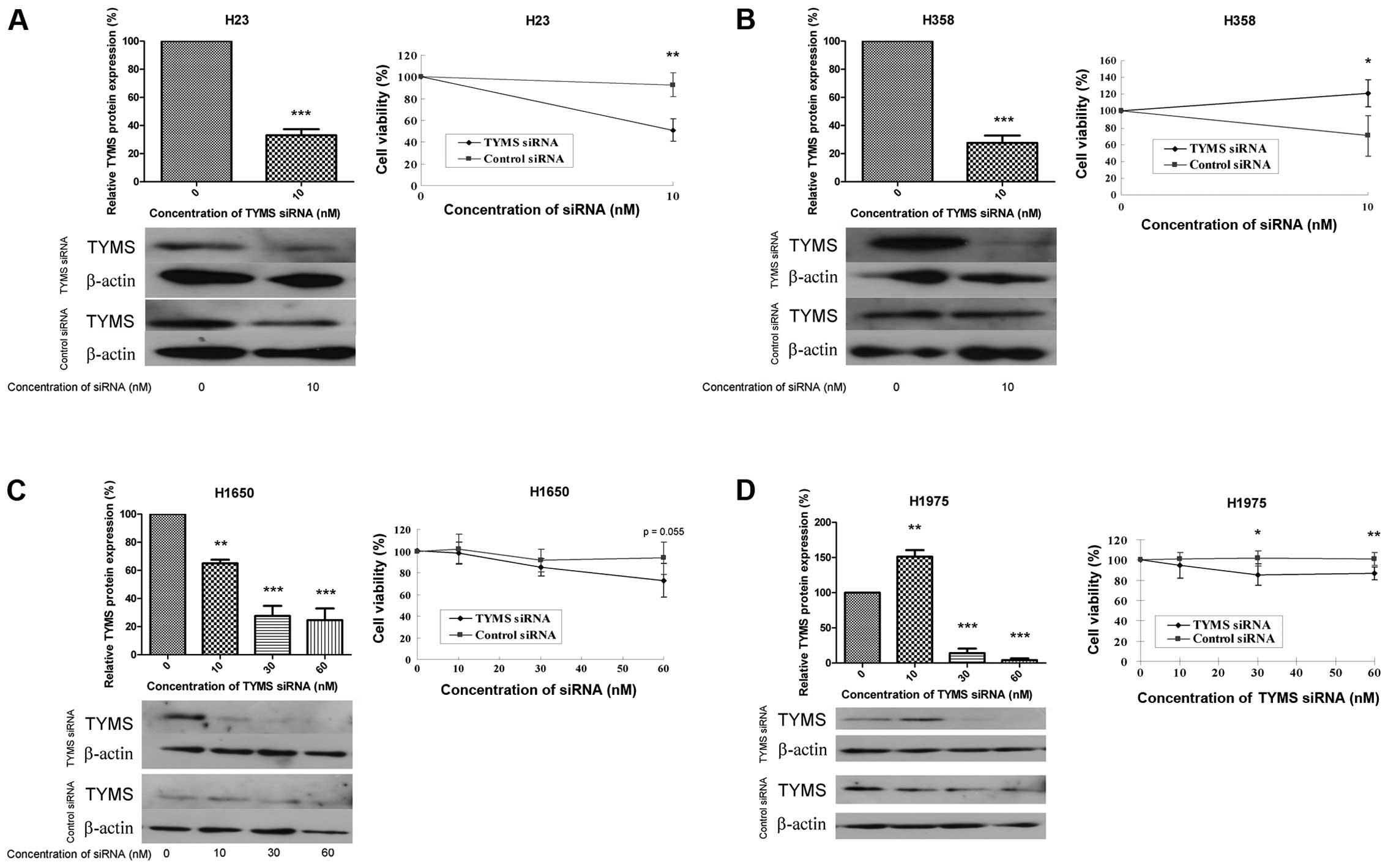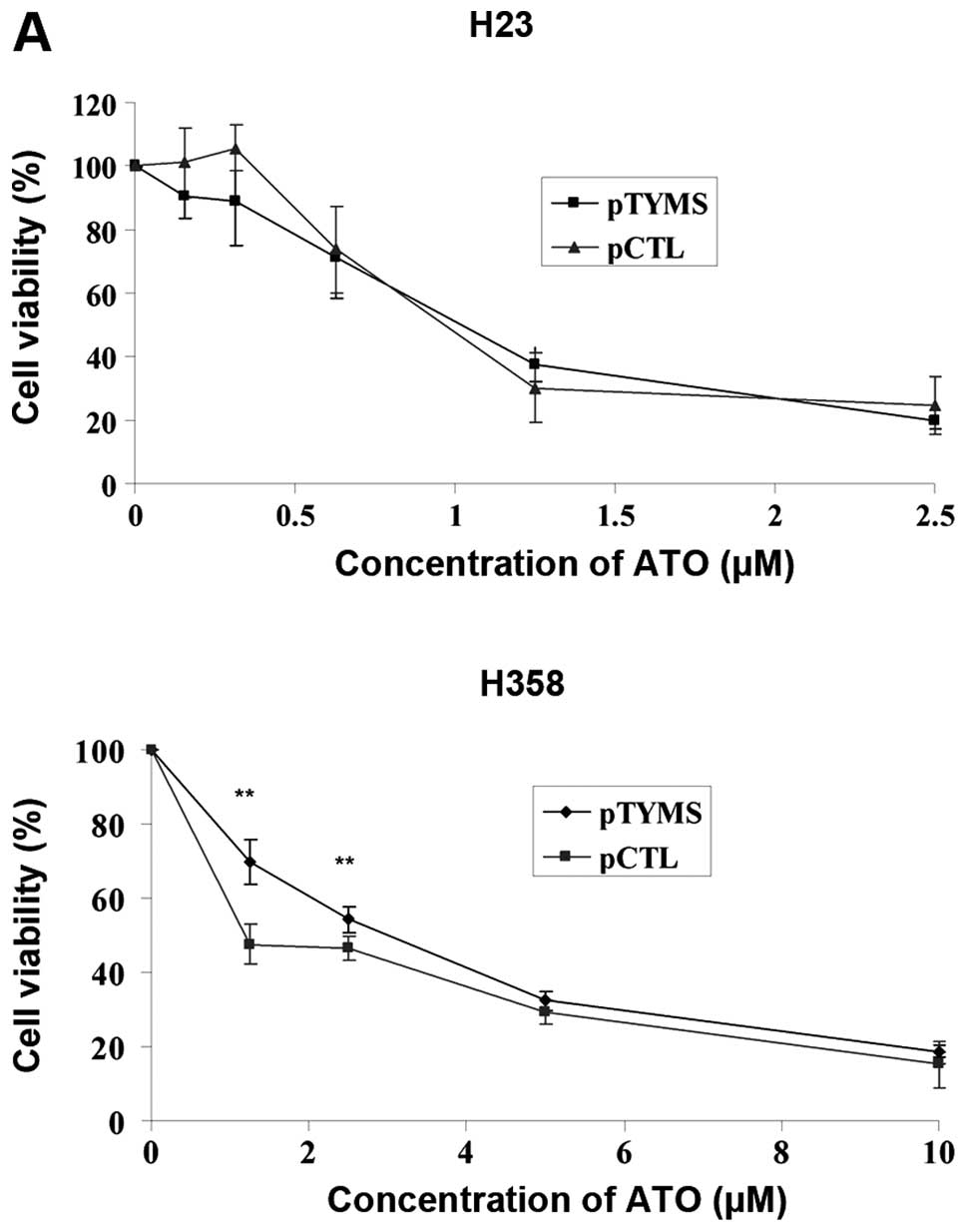|
1.
|
Rahman L, Voeller D, Rahman M, et al:
Thymidylate synthase as an oncogene: a novel role for an essential
DNA synthesis enzyme. Cancer Cell. 5:341–351. 2004. View Article : Google Scholar : PubMed/NCBI
|
|
2.
|
Biason P, Visentin M, Talamini R, et al:
Polymorphic thymidylate synthase gene impacts on overall survival
of patients with epithelial ovarian cancer after platinum-based
chemotherapy. Pharmacogenomics. 13:1609–1619. 2012. View Article : Google Scholar
|
|
3.
|
Bolocan A, Ion D, Ciocan DN and Paduraru
DN: Prognostic and predictive factors in colorectal cancer.
Chirurgia (Bucur). 107:555–563. 2012.PubMed/NCBI
|
|
4.
|
Igawa S, Ryuge S, Wada M, et al:
Pemetrexed for previously treated patients with non-small cell lung
cancer and differences in efficacy according to thymidylate
synthase expression. Chemotherapy. 58:313–320. 2012. View Article : Google Scholar : PubMed/NCBI
|
|
5.
|
Ruiz-Tovar J, Fernandez-Contreras ME,
Martin-Perez E and Gamallo C: Association of thymidylate synthase
and hypoxia inducible factor-1alpha DNA polymorphisms with
pancreatic cancer. Tumori. 98:364–369. 2012.PubMed/NCBI
|
|
6.
|
Tamatani T, Ferdous T, Takamaru N, et al:
Antitumor efficacy of sequential treatment with docetaxel and
5-fluorouracil against human oral cancer cells. Int J Oncol.
41:1148–1156. 2012.PubMed/NCBI
|
|
7.
|
Yang Z, Liu HX and Zhang XF: 2R of
thymidylate synthase 5′-untranslated enhanced region contributes to
gastric cancer risk: a meta-analysis. Asian Pac J Cancer Prev.
13:1923–1927. 2012.
|
|
8.
|
Subbarayan PR, Lee K and Ardalan B:
Arsenic trioxide suppresses thymidylate synthase in 5-FU-resistant
colorectal cancer cell line HT29 in vitro re-sensitizing cells to
5-FU. Anticancer Res. 30:1157–1162. 2010.
|
|
9.
|
Rangwala F, Williams KP, Smith GR, et al:
Differential effects of arsenic trioxide on chemosensitization in
human hepatic tumor and stellate cell lines. BMC Cancer.
12:4022012. View Article : Google Scholar : PubMed/NCBI
|
|
10.
|
Arocho A, Chen B, Ladanyi M and Pan Q:
Validation of the 2-DeltaDeltaCt calculation as an alternate method
of data analysis for quantitative PCR of BCR-ABL P210 transcripts.
Diagn Mol Pathol. 15:56–61. 2006.PubMed/NCBI
|
|
11.
|
Pressacco J, Mitrovski B, Erlichman C and
Hedley DW: Effects of thymidylate synthase inhibition on thymidine
kinase activity and nucleoside transporter expression. Cancer Res.
55:1505–1508. 1995.PubMed/NCBI
|
|
12.
|
Kousparou CA, Yiacoumi E, Deonarain MP and
Epenetos AA: Generation of a selectively cytotoxic fusion protein
against p53 mutated cancers. BMC Cancer. 12:3382012. View Article : Google Scholar : PubMed/NCBI
|
|
13.
|
Ardalan B, Subbarayan PR, Ramos Y, et al:
A phase I study of 5-fluorouracil/leucovorin and arsenic trioxide
for patients with refractory/relapsed colorectal carcinoma. Clin
Cancer Res. 16:3019–3027. 2010. View Article : Google Scholar : PubMed/NCBI
|
|
14.
|
Bahlis NJ, McCafferty-Grad J,
Jordan-McMurry I, et al: Feasibility and correlates of arsenic
trioxide combined with ascorbic acid-mediated depletion of
intracellular glutathione for the treatment of relapsed/refractory
multiple myeloma. Clin Cancer Res. 8:3658–3668. 2002.
|
|
15.
|
Shen ZX, Chen GQ, Ni JH, et al: Use of
arsenic trioxide (As2O3) in the treatment of acute promyelocytic
leukemia (APL): II. Clinical efficacy and pharmacokinetics in
relapsed patients. Blood. 89:3354–3360. 1997.PubMed/NCBI
|
|
16.
|
Pao W and Hutchinson KE: Chipping away at
the lung cancer genome. Nat Med. 18:349–351. 2012. View Article : Google Scholar : PubMed/NCBI
|
|
17.
|
Au WY: A biography of arsenic and medicine
in Hong Kong and China. Hong Kong Med J. 17:507–513.
2011.PubMed/NCBI
|
|
18.
|
Soignet SL, Frankel SR, Douer D, et al:
United States multi-center study of arsenic trioxide in relapsed
acute promyelocytic leukemia. J Clin Oncol. 19:3852–3860.
2001.PubMed/NCBI
|
|
19.
|
Gore SD, Gojo I, Sekeres MA, et al: Single
cycle of arsenic trioxide-based consolidation chemotherapy spares
anthracycline exposure in the primary management of acute
promyelocytic leukemia. J Clin Oncol. 28:1047–1053. 2010.
View Article : Google Scholar
|
|
20.
|
Cai X, Shen YL, Zhu Q, et al: Arsenic
trioxide-induced apoptosis and differentiation are associated
respectively with mitochondrial transmembrane potential collapse
and retinoic acid signaling pathways in acute promyelocytic
leukemia. Leukemia. 14:262–270. 2000. View Article : Google Scholar
|
|
21.
|
Jing Y, Dai J, Chalmers-Redman RM, Tatton
WG and Waxman S: Arsenic trioxide selectively induces acute
promyelocytic leukemia cell apoptosis via a hydrogen
peroxide-dependent pathway. Blood. 94:2102–2111. 1999.PubMed/NCBI
|
|
22.
|
Mahieux R, Pise-Masison C, Gessain A, et
al: Arsenic trioxide induces apoptosis in human T-cell leukemia
virus type 1- and type 2-infected cells by a caspase-3-dependent
mechanism involving Bcl-2 cleavage. Blood. 98:3762–3769. 2001.
View Article : Google Scholar
|
|
23.
|
Park WH, Seol JG, Kim ES, et al: Arsenic
trioxide-mediated growth inhibition in MC/CAR myeloma cells via
cell cycle arrest in association with induction of cyclin-dependent
kinase inhibitor, p21, and apoptosis. Cancer Res. 60:3065–3071.
2000.PubMed/NCBI
|
|
24.
|
Shim MJ, Kim HJ, Yang SJ, Lee IS, Choi HI
and Kim T: Arsenic trioxide induces apoptosis in chronic
myelogenous leukemia K562 cells: possible involvement of p38 MAP
kinase. J Biochem Mol Biol. 35:377–383. 2002. View Article : Google Scholar : PubMed/NCBI
|
|
25.
|
Wang ZG, Rivi R, Delva L, et al: Arsenic
trioxide and melarsoprol induce programmed cell death in myeloid
leukemia cell lines and function in a PML and PML-RARalpha
independent manner. Blood. 92:1497–1504. 1998.PubMed/NCBI
|
|
26.
|
Lallemand-Breitenbach V, Jeanne M,
Benhenda S, et al: Arsenic degrades PML or PML-RARalpha through a
SUMO-triggered RNF4/ubiquitin-mediated pathway. Nat Cell Biol.
10:547–555. 2008. View
Article : Google Scholar : PubMed/NCBI
|
|
27.
|
Zhang XW, Yan XJ, Zhou ZR, et al: Arsenic
trioxide controls the fate of the PML-RARalpha oncoprotein by
directly binding PML. Science. 328:240–243. 2010. View Article : Google Scholar : PubMed/NCBI
|
|
28.
|
Han B, Zhou G, Zhang Q, et al: Effect of
arsenic trioxide (ATO) on human lung carcinoma PG cell line: ATO
induced apoptosis of PG cells and decreased expression of Bcl-2,
Pgp. J Exp Ther Oncol. 4:335–342. 2004.PubMed/NCBI
|
|
29.
|
Cheng Y, Chang LW and Tsou TC:
Mitogen-activated protein kinases mediate arsenic-induced
down-regulation of survivin in human lung adenocarcinoma cells.
Arch Toxicol. 80:310–318. 2006. View Article : Google Scholar : PubMed/NCBI
|
|
30.
|
Jin HO, Yoon SI, Seo SK, et al:
Synergistic induction of apoptosis by sulindac and arsenic trioxide
in human lung cancer A549 cells via reactive oxygen
species-dependent down-regulation of survivin. Biochem Pharmacol.
72:1228–1236. 2006. View Article : Google Scholar : PubMed/NCBI
|
|
31.
|
Kim HR, Kim EJ, Yang SH, et al:
Combination treatment with arsenic trioxide and sulindac augments
their apoptotic potential in lung cancer cells through activation
of caspase cascade and mitochondrial dysfunction. Int J Oncol.
28:1401–1408. 2006.
|
|
32.
|
De Sousa Abreu R, Penalva LO, Marcotte EM
and Vogel C: Global signatures of protein and mRNA expression
levels. Mol Biosyst. 5:1512–1526. 2009.PubMed/NCBI
|
|
33.
|
Belvedere O, Puglisi F, Di Loreto C, et
al: Lack of correlation between immunohistochemical expression of
E2F-1, thymidylate synthase expression and clinical response to
5-fluorouracil in advanced colorectal cancer. Ann Oncol. 15:55–58.
2004. View Article : Google Scholar
|
|
34.
|
Phan J, Steadman DJ, Koli S, et al:
Structure of human thymidylate synthase suggests advantages of
chemotherapy with noncompetitive inhibitors. J Biol Chem.
276:14170–14177. 2001.PubMed/NCBI
|
|
35.
|
Salo-Ahen OM and Wade RC: The
active-inactive transition of human thymidylate synthase: targeted
molecular dynamics simulations. Proteins. 79:2886–2899. 2011.
View Article : Google Scholar : PubMed/NCBI
|
|
36.
|
Takezawa K, Okamoto I, Tsukioka S, et al:
Identification of thymidylate synthase as a potential therapeutic
target for lung cancer. Br J Cancer. 103:354–361. 2010. View Article : Google Scholar : PubMed/NCBI
|
|
37.
|
Melo SP, Yoshida A and Berger FG:
Functional dissection of the N-terminal degron of human thymidylate
synthase. Biochem J. 432:217–226. 2010. View Article : Google Scholar : PubMed/NCBI
|
|
38.
|
Jing Y, Wang L, Xia L, et al: Combined
effect of all-trans retinoic acid and arsenic trioxide in acute
promyelocytic leukemia cells in vitro and in vivo. Blood.
97:264–269. 2001. View Article : Google Scholar : PubMed/NCBI
|
|
39.
|
Kim J, Lee JJ, Gardner D and Beachy PA:
Arsenic antagonizes the Hedgehog pathway by preventing ciliary
accumulation and reducing stability of the Gli2 transcriptional
effector. Proc Natl Acad Sci USA. 107:13432–13437. 2010. View Article : Google Scholar : PubMed/NCBI
|
|
40.
|
Kinjo K, Kizaki M, Muto A, et al: Arsenic
trioxide (As2O3)-induced apoptosis and differentiation in retinoic
acid-resistant acute promyelocytic leukemia model in
hGM-CSF-producing transgenic SCID mice. Leukemia. 14:431–438. 2000.
View Article : Google Scholar : PubMed/NCBI
|
|
41.
|
Lallemand-Breitenbach V, Guillemin MC,
Janin A, et al: Retinoic acid and arsenic synergize to eradicate
leukemic cells in a mouse model of acute promyelocytic leukemia. J
Exp Med. 189:1043–1052. 1999. View Article : Google Scholar : PubMed/NCBI
|
|
42.
|
Li Y, Sun X, Wang L, Zhou Z and Kang YJ:
Myocardial toxicity of arsenic trioxide in a mouse model.
Cardiovasc Toxicol. 2:63–73. 2002. View Article : Google Scholar : PubMed/NCBI
|
|
43.
|
Au WY, Kumana CR, Kou M, et al: Oral
arsenic trioxide in the treatment of relapsed acute promyelocytic
leukemia. Blood. 102:407–408. 2003. View Article : Google Scholar : PubMed/NCBI
|
|
44.
|
Siu CW, Au WY, Yung C, et al: Effects of
oral arsenic trioxide therapy on QT intervals in patients with
acute promyelocytic leukemia: implications for long-term cardiac
safety. Blood. 108:103–106. 2006. View Article : Google Scholar : PubMed/NCBI
|
















